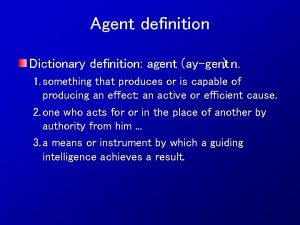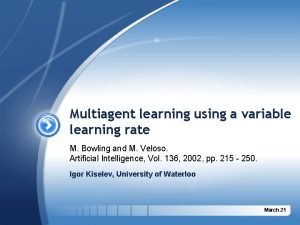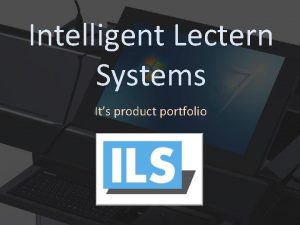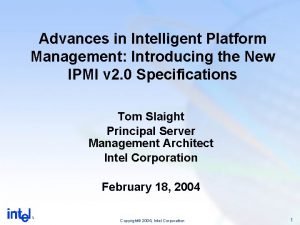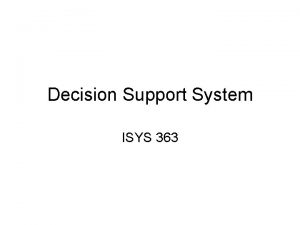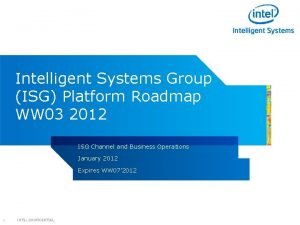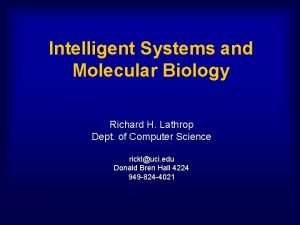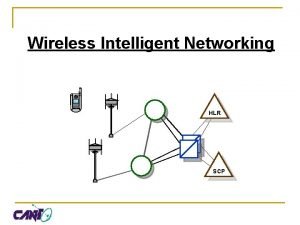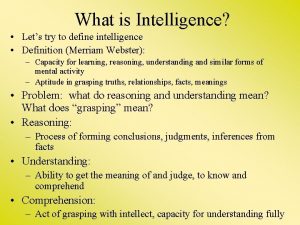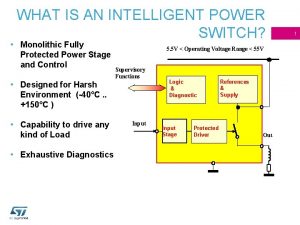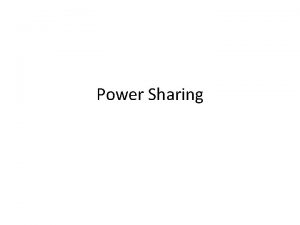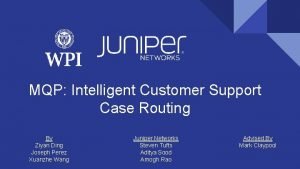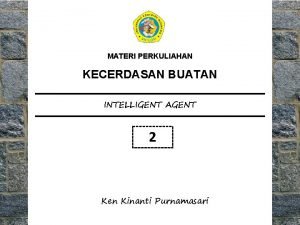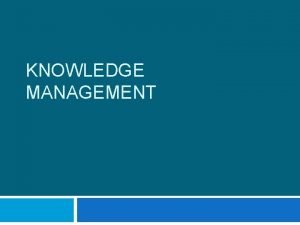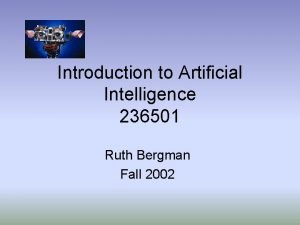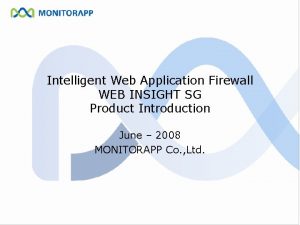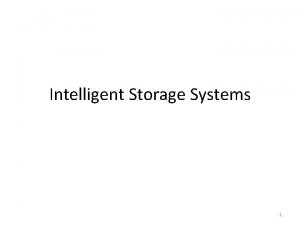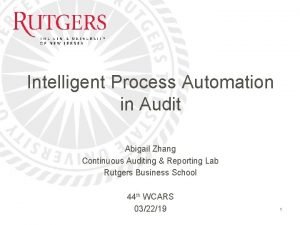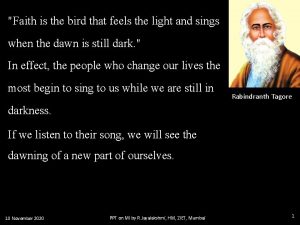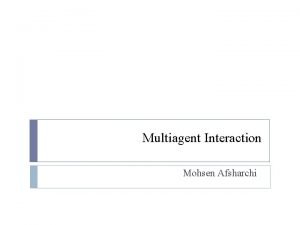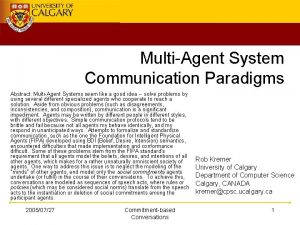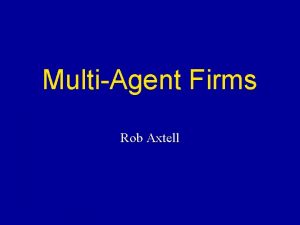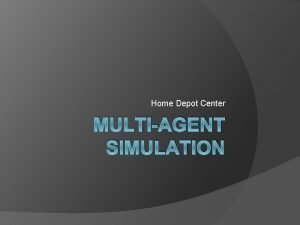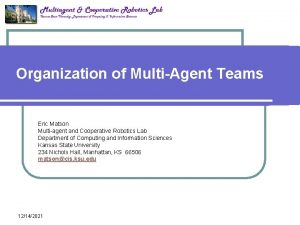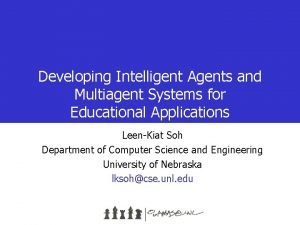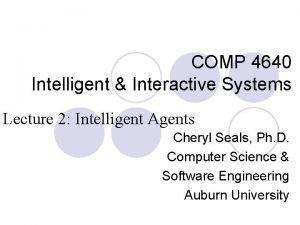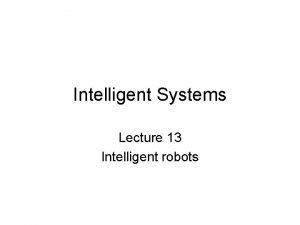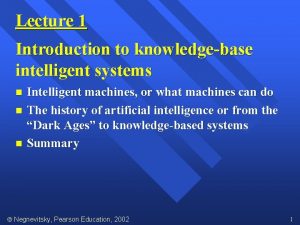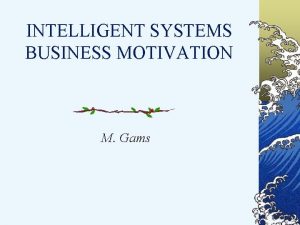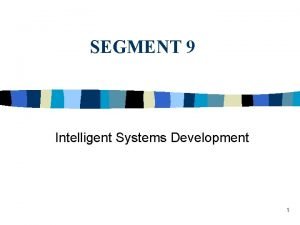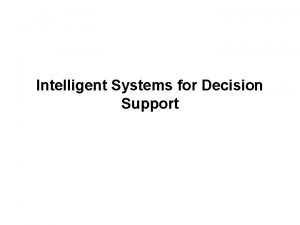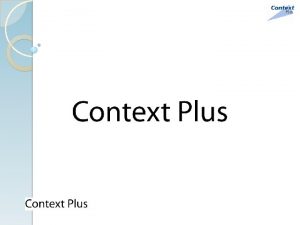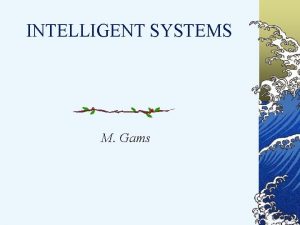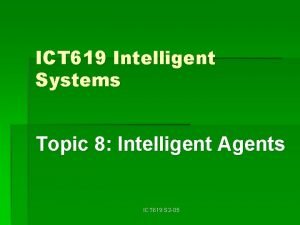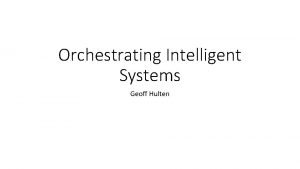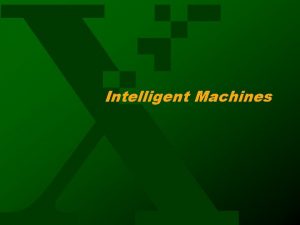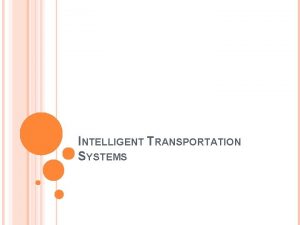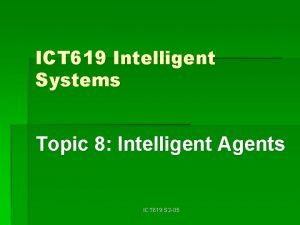Intelligent Systems Lecture 25 MultiAgent Systems 15 12


























- Slides: 26

Intelligent Systems Lecture 25 Multi-Agent Systems 15. 12. 2005

Main concepts of agent • the beliefs that agents have—the information they have about their environment, which may be incomplete or incorrect; • the goals that agents will try to achieve; • the actions that agents perform and the effects of these actions; • the ongoing interaction that agents have— how agents interact with each other and their environment over time. 15. 12. 2005 2

Metamodel showing links between goals and tasks 15. 12. 2005 3

Metamodel of concepts 15. 12. 2005 4

Canonical view of a multi-agent system 15. 12. 2005 5

ACL – Agent Communication Languages • KQML (Knowledge Query and Manipulation Language) is an effort to standardise the communication language between software agents. The standard defines the semantical meaning of ASCII expressions, being exchanged in an agent community and makes abstraction of transport issues. From the outside, it appears as if each agent manages its own knowledge base, which typically consists of 'beliefs' and 'goals' (determining the agent's behavior). Part of this knowledge may be shared with other agents, which can query or manipulate it. • KQML defines performatives for retrieval, insertion or deletion of knowledge ('ask' and 'tell', 'insert' and 'delete'), subscription to services ('subscribe'), publication of agent capabilities ('advertise') and others. Unfortunately many different flavours have been created, so there is little inter-operability between these systems. • In the following example, agent 'john' tells some 'content' to agent 'lisa' in reply to a previous message 'ref 1', with the content expressed in the 'KIF' language using the 'family' ontology: • (tell : sender john : receiver lisa : language KIF : ontology family : in-reply-to ref 1 : content (<= (grandparent ? x ? z) (and (parent ? x ? y) (parent ? y ? z)))) 15. 12. 2005 6

ACL – Agent Communication Languages (2) • FIPA ACL (Foundation for Intelligent Physical Agents) The syntax of this FIPA ACL is very similar to KQML syntax rules. FIPA recognised the need for performatives that have well-defined semantics, but also that its proposed semantics or "pragmatics" need further testing before they really can be considered as normative. So, ACL hasn't yet proven its use in an open environment such as the Internet. Interoperability between FIPA compliant platforms is one of the key issues tackled by a European ACTS project FACTS (FIPA Agent Communication Technologies and Services) 15. 12. 2005 7

ACL – Agent Communication Languages (3) • The Knowledge Interchange Format (KIF) defined by Stanford University. • KIF is capable of representing first order predicate logic and its syntax is based on Common LISP. • KIF facilitates the exchange of knowledge propositions between artificial intelligence systems and was used in conjunction with KQML in major American research projects on Knowledge Representation and collaborative multi-agent systems. • As an example of KIF content, we've included a logic sentence "if x is a parent of y, and y is a parent of z, x is a grandparent of z", in the above example of a KQML message. 15. 12. 2005 8

ACL – Agent Communication Languages (4) • The Semantic Language (SL). Like KIF, the Semantic Language recently proposed by FIPA has been defined to express first order predicate logic. • It has been declined into three different profiles : – SL 0 for the sake of agent management essentially, where only simple actions and propositions can be expressed, – SL 1 with additional Boolean operations, – SL 2 which only allows to express decidable propositions • The e. Xtensible Markup Language (XML) • This is advanced HTML for representation of structure of objects and relations between them 15. 12. 2005 9

Mobile agent • Mobile objects, sometimes called mobile agents, are bits of code that can move to another execution site (presumably on a different machine) under their own programmatic control, where they can then eciently interact with the local environment. Commercial instantiations of this technology include Aglets from IBM, Concordia from Mitsubishi, and Voyager from Object. Space. • Advantages: – Network bandwidth: for some database queries or electronic commerce applications, it is more ecient to perform tests on data by bringing the tests to the data than by bringing large amounts of data to the testing program. – Parallelism: mobile agents can be spawned in parallel to accomplish many tasks at once. • Disadvantages: – In a fashion similar to that of DOOP programming, an agent developer must programmatically specify where to go and how to interact with the target environment. – There is generally little coordination support to encourage interactions among multiple (mobile) participants. – Agents must be written in the programming language supported by the execution environment, whereas many other distributed technologies support heterogeneous communities of components, written in diverse programming languages. 15. 12. 2005 10

Swarm Intelligence • www. swarm. org • Swarm Intelligence (SI) is the property of a system whereby the collective behaviours of (unsophisticated) agents interacting locally with their environment cause coherent functional global patterns to emerge. • SI provides a basis with which it is possible to explore collective (or distributed) problem solving without centralized control or the provision of a global model. • Colony of ANT 15. 12. 2005 11

Applications of MAS • WEB-services • Business distributed applications (planning and control of business, in particular, based on Internet/Intranet) • Searching systems • Cooperation of robots (for example, in soccer and battle field) • Programming of AI in games 15. 12. 2005 12

A Multi-Agent Platform for On-line Services (MAPOS) Most initiatives that recently tried to use intelligent agents for some kind of electronic commerce followed a similar approach : a user contacts an intermediate platform that hosts his Personal Assistant (PA) and some brokerage services. The transaction life-cycle follows a variation of the Contract-net Protocol between Personal Assistant, Service Broker (SB) and On-line Provider (OLP) agents, which represent the sellers or content providers. After service completion, billing/after sales aspects are controlled by the service broker. This scenario is illustrated in Figure. 15. 12. 2005 13

A Multi-Agent Platform for On-line Services (MAPOS) (2) 15. 12. 2005 14

A Multi-Agent Platform for On-line Services (MAPOS) (3) • The MAPOS platform has been completely written in Java and has been based on the Java Agent Template (JAT), which uses KQML mainly for agent management purposes. As content language we used XML embedded within KQML messages. As the OLP and its SCMs belong to the same entity, the interfaces between are normally more proprietary, which we reflected in choosing here RMI as communication mechanism. An overall picture of the MAPOS architecture is given in Figure 15. 12. 2005 15

The MAPOS architecture 15. 12. 2005 16

MAS in operation planning • Operation planning is the most prevalent task in commercial operations • The tasks of Operation Planning and Scheduling (OPS) under multiple resource and temporal constraints are of the keenest interest among other tasks • Although OPS problem was studied for several decades, it remained to be a subject of the permanent research aiming at development of an approach and architecture that allow to cope with its high computational complexity. • At present new perspectives emerge due to new accomplishments and achievements in the area of intelligent agent-based technology 15. 12. 2005 17

MAS in operation planning (2) • The model of OPS task is formulated in terms of the contract allocation, when contractors are meant as service providers. • Each agent is implemented as an autonomous intelligent software agent. • In this metaphor, each contract is considered as a single operation scheduled for a service action. • Contract allocation task is solved on the basis of auction-based negotiation protocol managed by the meta-agent. Auction is used as a coordination mechanism 15. 12. 2005 18

Meta-agent domain specified in terms of • Entire list of operations to be executed within a schedule • Plan and schedule of operation execution • Quality of Service vector assessing the plan The task of meta-agent Coordination of the particular decisions of agent-contractors AC 1 MA AC 4 AC 2 AC 3 AC 5 Agent-contractor domains is specified in terms of • Resources • Multitude of constraints to be met by it • Scenarios of operation execution • Plan and schedule of operation to executed by it Agent’s task • Constraints satisfaction • Maximal profit 15. 12. 2005 19

Agents’ interaction protocol • An “auction” is a metaphor of agents’ negotiation protocol to coordinate particular decisions to meet the entire batch of constraints and to maximize total benefit of OPS. An “auction” consists of a sequence of particular phases, which are called “bargains” and aimed at allocation a single operation (single “service” providing) to an agent-contractor. Each bargain scenario consists of several meta-agent’s action that are like the following ones: • announcement of a service to be provided, • receiving and assessment of the proposals (“bids”) of agentcontractors, • selection of a winner, i. e. an agent-contractor which is supposed to provide the respective service. • An agent-contractor performs the following tasks: • receives announcement, • evaluates its capabilities to provide service announced and makes decision, • returns decision to meta-agent, • planes to provide a service if win. 15. 12. 2005 20

Meta-agent. Knowledge base components Strategy and management of auction Operation announcement order Criteria for selection a bargain winner Criteria for selection the final decision from generated ones 15. 12. 2005 21

Agent-contractor. Knowledge base components Constraints satisfaction Specification of the scenario of each single operation Actions Scenarios Model of resources Quality of service vector 15. 12. 2005 22

The architecture of basic technology for business based on MAS (A. N. Terekhov, A. M. Kudinov, S. I. Makarov, R. A. Boudagov “Basic Technology for creating Mobile Distributed Systems”, Proc. of Int. Workshop of Management, 2002) • Methodologies, which have to be used in different stages of system’s life cycle. • The referent model of data domain as different representations and the unified method of description of company. • The ontological basis, defining basic terms of data domain and its interdependence. • Language tools for model analysis of specifications, formalization and programming. • Toolkits automating basic process of information system construction life cycle (specifications and analysis, engineering, testing, projects management). • The structure of technological platform includes FIPA and OMG M 15. 12. 2005 23

One main principle of building of systems for business • Multi-agent construction of toolkits and applicable tools. • The main feature of engineering and reengineering of mobile information systems is a dynamic of construction of new business rules and effective modeling of network organizations. • Multi-agent systems are used both for technological and application-oriented problems. • Multi-agent infrastructure is in fact a multilevel shell of the information system, which represent business rules and communication of its participants. • The main characteristic of multi-agent system is its mobility. The mobility is represented in four aspects – mobile users, computers, programs and data. • Hereinafter the mobile global information system will be considered as a set of technological and software tools mounted on mobile and stationary objects (cars, airplanes, ships, trains) and executed software modules, represented 15. 12. 2005 24 as mobile agents.

15. 12. 2005 25

Agent's types • Adapter-agent. The agents of this type are designed for using on the nodes of corporative network, containing data sources These agents are responsible for getting information from databases, its conversion to the type required by used ontology and its transferring to collectoragent. This agents can be dynamically configured for particular data storage by means of request vocabulary in XML format. • Collector-agent. These agents are responsible for collecting information from distributed sources and its storing in common corporative database represented as a General Ledger Facility. The mobility of collector-agents increases the efficiency and reliability of intercommunication with adapter-agents. They can be moved to the network node, witch contains data storage and corresponding adapter-agent. . • Administrator-agent. This agent provides user’s interface for remote monitoring and agent’s system control. Administrator-agent may activate the full system of agents by means of only one terminal. Therefore, the information system administrator, using the access to local area network can get information about all agents and CORBAservers and also configure them without interruption of the work of the system. 15. 12. 2005 26
 Site:slidetodoc.com
Site:slidetodoc.com Multiagent learning using a variable learning rate
Multiagent learning using a variable learning rate Decision support systems and intelligent systems
Decision support systems and intelligent systems 01:640:244 lecture notes - lecture 15: plat, idah, farad
01:640:244 lecture notes - lecture 15: plat, idah, farad Intelligent lectern systems
Intelligent lectern systems Intelligent platform management interface market demand
Intelligent platform management interface market demand Isys intelligent systems
Isys intelligent systems Hw-q67b
Hw-q67b Intelligent systems for molecular biology
Intelligent systems for molecular biology Operating system lecture notes
Operating system lecture notes Lecture sound systems
Lecture sound systems Lecture sound systems
Lecture sound systems Wireless intelligent networking
Wireless intelligent networking Intelligence vs intelligent
Intelligence vs intelligent Intelligent power switch
Intelligent power switch Intelligent sharing of power is done among:
Intelligent sharing of power is done among: Intelligent customer routing
Intelligent customer routing Contoh peas
Contoh peas Intelligent techniques adalah
Intelligent techniques adalah Structure of intelligent agents
Structure of intelligent agents Intelligent workload management
Intelligent workload management Ace web application firewall
Ace web application firewall Intelligent storage system
Intelligent storage system Continuous auditing workflow
Continuous auditing workflow Maths bot starter
Maths bot starter Utility based agent in ai
Utility based agent in ai I am existentially intelligent, i am someone who ....
I am existentially intelligent, i am someone who ....
